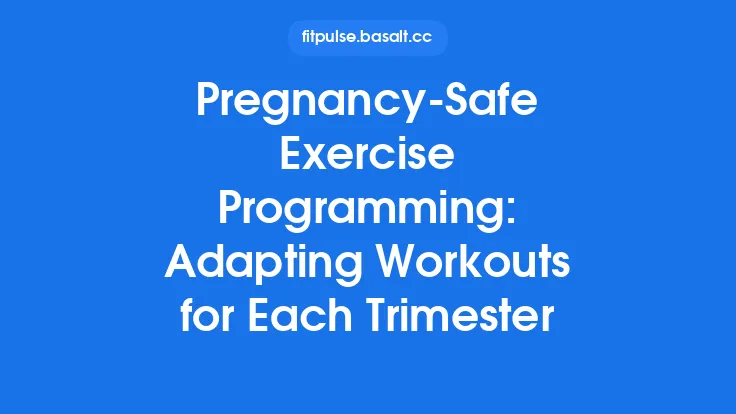Youth cardio training isn’t just a scaled‑down version of adult workouts; it’s a distinct discipline that respects the unique physiological, psychological, and developmental characteristics of children and adolescents. When designed thoughtfully, cardio activities can enhance heart health, improve aerobic capacity, support healthy weight management, and foster a lifelong love of movement—all while safeguarding the growing body from undue stress. This article delves into the foundational concepts that make youth cardio both safe and effective, offering practical guidance for coaches, parents, teachers, and anyone responsible for guiding young athletes through the world of aerobic exercise.
Understanding the Developing Cardiovascular System
Cardiac anatomy and function
Children’s hearts are proportionally larger relative to body size compared to adults, and the myocardial fibers are more compliant. This results in a higher resting stroke volume relative to body mass, allowing the heart to pump a larger proportion of blood with each beat. However, the absolute maximal cardiac output is limited by a lower maximal heart rate, which is typically higher in youth (often 200–220 bpm in pre‑pubescent children) and declines gradually with age.
Oxygen transport and utilization
The oxygen‑carrying capacity of blood in youth is comparable to adults, but the peripheral extraction of oxygen (the arteriovenous oxygen difference) is less efficient because capillary density and mitochondrial enzyme activity are still maturing. Consequently, children rely more heavily on anaerobic glycolysis during high‑intensity bursts, which explains their natural affinity for intermittent, game‑like activities.
Metabolic considerations
Glycogen stores in young athletes are smaller, and their ability to oxidize fats during prolonged low‑intensity exercise is not as fully developed. This makes it essential to balance session length and intensity to avoid premature fatigue and ensure adequate recovery.
Neurodevelopmental factors
The central nervous system of children is still refining motor patterns, proprioception, and coordination. Activities that incorporate varied movement patterns, rhythmic timing, and decision‑making (e.g., tag games, dance routines) align well with these developmental windows, promoting both cardiovascular fitness and neuromuscular competence.
Key Principles for Youth Cardio Safety
- Prioritize movement quality over volume
Proper technique—whether it’s a running stride, cycling pedal stroke, or swimming pull—reduces joint stress and improves efficiency. Coaches should allocate time for skill drills before increasing workload.
- Maintain a moderate intensity ceiling
While children can reach high heart rates, sustained maximal effort is unnecessary for aerobic development. Aim for 50–70 % of age‑predicted maximal heart rate (or a “moderate” rating of perceived exertion on a 0–10 scale). This range supports cardiovascular adaptations without overtaxing the immature musculoskeletal system.
- Incorporate built‑in rest and active recovery
Short, frequent rest intervals (30 seconds to 2 minutes) or low‑intensity active recovery (walking, light jogging) are essential, especially during interval‑based games. They allow phosphocreatine stores to replenish and prevent excessive lactate accumulation.
- Monitor for signs of overtraining
Persistent fatigue, irritability, decreased performance, or frequent minor injuries can indicate that training load exceeds recovery capacity. Adjust session frequency or intensity promptly.
- Ensure appropriate footwear and equipment
Shoes should provide adequate cushioning, support, and fit the specific activity (e.g., running shoes for track, cleats for field sports). Equipment such as bikes or rowing machines must be sized to the child’s height to maintain proper biomechanics.
- Create a temperature‑controlled environment
Children are less efficient at thermoregulation. Avoid extreme heat or cold, provide ample hydration breaks, and schedule sessions during cooler parts of the day when outdoor temperatures exceed 30 °C (86 °F).
Choosing Age‑Appropriate Cardio Activities
| Age Range | Ideal Modalities | Rationale |
|---|---|---|
| 5‑8 years | Playground games (tag, dodgeball), obstacle courses, basic swimming, bike riding with training wheels, rhythmic dance | Emphasizes fun, gross motor skill development, and short bursts of activity that match natural attention spans. |
| 9‑12 years | Structured team sports (soccer, basketball), interval running drills, beginner rowing, aerobic circuits, jump rope | Introduces more sustained aerobic effort while still leveraging the child’s preference for varied, game‑like formats. |
| 13‑15 years | Longer distance runs (5 km), cycling on safe routes, swimming laps, aerobic fitness classes (e.g., Zumba, HIIT with low impact), cross‑country skiing (where available) | Aligns with increased aerobic capacity and the ability to handle longer continuous sessions, while still allowing for interval work. |
| 16‑18 years | Competitive track events, road cycling, endurance swimming, rowing, high‑intensity interval training (HIIT) with proper supervision | Supports peak adolescent aerobic development and can serve as a bridge to adult training if desired. |
Key selection criteria
- Enjoyment factor: Children are more likely to adhere to activities they find intrinsically rewarding.
- Skill progression: Choose activities that allow incremental skill acquisition (e.g., mastering a swimming stroke before increasing distance).
- Safety profile: Prioritize low‑impact options for younger children to protect growth plates and joints.
- Accessibility: Ensure the activity can be performed in the child’s community or school setting without prohibitive cost.
Designing a Balanced Youth Cardio Session
A typical 45‑minute session for a 10‑year‑old might follow this structure:
| Segment | Duration | Focus | Example |
|---|---|---|---|
| Warm‑up (Dynamic) | 5 min | Joint mobility, light activation | Arm circles, high knees, lateral shuffles |
| Skill/Technique Drill | 10 min | Movement quality, pattern reinforcement | Proper running form drills (mid‑foot strike, arm swing) |
| Main Cardio Block | 20 min | Aerobic stimulus, varied intensity | 4 × 3‑minute “play” intervals (e.g., mini‑soccer) with 2‑minute active recovery (walking) |
| Cool‑down (Static Stretch) | 5 min | Gradual heart‑rate reduction, flexibility | Hamstring stretch, calf stretch, deep breathing |
| Reflection/Feedback | 5 min | Brief discussion on how the child felt, any discomfort | “What part felt easy? What felt hard?” |
Intensity modulation
- Use the “talk test” as a simple gauge: during the main cardio block, children should be able to speak short sentences but not sing.
- For interval formats, keep high‑intensity bursts short (30 seconds to 2 minutes) to align with their natural anaerobic capacity, followed by equal or longer recovery periods.
Progression cues
- Increase the number of intervals before extending the duration of each interval.
- Introduce slight variations in terrain (e.g., gentle hills) once basic flat‑ground proficiency is established.
- Add light resistance (e.g., small ankle weights) only after the child demonstrates consistent technique and has clearance from a qualified professional.
Progression Strategies for Growing Athletes
- Linear progression for beginners
Start with a baseline volume (e.g., 2 sessions per week, 20 minutes each) and add 5 % to total time or distance each week, never exceeding a 10 % increase in any single session.
- Undulating periodization for intermediate youth
Alternate weeks of moderate volume with weeks of slightly higher intensity to stimulate adaptation while preventing monotony. Example: Week 1 – 3 × 30‑minute moderate runs; Week 2 – 2 × 30‑minute runs + 1 × 20‑minute interval session.
- Skill‑first approach for advanced adolescents
When technical proficiency is high, focus on specific cardio adaptations (e.g., lactate threshold work) by incorporating tempo runs or sustained efforts at 70–80 % of maximal heart rate for 10–15 minutes, always preceded by a thorough skill refresher.
- Cross‑training to avoid overuse
Rotate modalities (running, swimming, cycling) on a weekly basis to distribute load across different muscle groups and joint complexes, reducing the risk of repetitive strain.
- Individualization based on growth spurts
During rapid height increases, monitor for temporary declines in coordination or endurance. Reduce intensity temporarily and emphasize movement quality until the child adapts to new body dimensions.
Creating a Supportive Environment
- Parental involvement: Encourage parents to model active lifestyles, attend practice sessions, and provide logistical support (e.g., safe transport to the field).
- Positive coaching language: Use descriptive feedback (“Great knee lift on that sprint!”) rather than evaluative judgments (“You’re not fast enough”).
- Peer collaboration: Pair children of similar skill levels for drills, fostering a sense of camaraderie and shared progress.
- Accessible facilities: Ensure that the training space is well‑maintained, free of hazards, and equipped with age‑appropriate equipment.
- Education on self‑awareness: Teach children to recognize early signs of fatigue or discomfort and to communicate them promptly.
Common Misconceptions and Frequently Asked Questions
Myth: “Kids need to run as far as adults to build cardio fitness.”
Reality: Short, high‑intensity bouts interspersed with active recovery are more aligned with a child’s metabolic profile and keep sessions engaging.
Myth: “If a child enjoys a sport, they don’t need structured cardio.”
Reality: Even sport‑specific training benefits from deliberate aerobic conditioning to improve endurance, recovery between plays, and overall health.
FAQ: “How many cardio sessions per week are appropriate for a 12‑year‑old?”
A balanced schedule typically includes 3–4 sessions, each lasting 30–45 minutes, with at least one rest day between higher‑intensity days.
FAQ: “Can children use heart‑rate monitors?”
Yes, but they should be introduced as a learning tool rather than a strict performance metric. Simple visual cues (talk test, perceived exertion) are often sufficient for this age group.
FAQ: “Is it safe for adolescents to do high‑intensity interval training?”
When supervised, with proper technique and adequate recovery, HIIT can be safe for healthy adolescents. The intervals should be short (≤ 30 seconds) and the total session limited to 20 minutes.
By respecting the physiological realities of growing bodies, emphasizing skill development, and embedding cardio work within a fun, supportive framework, we lay a solid foundation for lifelong cardiovascular health. When youth cardio programs are thoughtfully crafted, they not only boost aerobic capacity but also nurture confidence, teamwork, and a positive relationship with movement—benefits that extend far beyond the gym or playing field.





